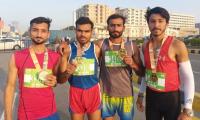Manifestos of the political parties are statements of intents and action plans for promoting socio-economic development and dealing with challenges confronting the country that they present before the masses at the time of elections to win their franchise. The performance of the party winning the mandate of the people is judged by the extent to which the party has been able to implement the promises made in its manifesto. The PML (N) manifesto among host of other issues, particularly laid emphasis on extremism, revival of the economy, surmounting energy crisis and improving the state of affairs in the education sector; the priority list generally known as four Es of PML (N).
An honest appraisal of the performance of the PML (N) government from the usual politicking by the opposition parties and the fulminations of the essential detractors of the government reveals that though the challenges inherited by it have not been fully surmounted but a substantial headway has been made in almost all the areas, specially the domain of Es.
A decisive battle was initiated against quelling religious extremism as manifested by the wave of terrorism gripping the country. Operation Zarb-e-Azb has been a tremendous success and almost all the areas of North Waziristan have been cleared. Almost all the areas of North Waziristan except far flung areas have been cleared. The final phase of the operation to clear the remaining areas has been ordered by the COAS on 25th of February during his visit to North Waziristan Agency. The success of this operation has also created space for intelligence based operations against the supporter and sleeping cell of terrorists throughout the country which are successfully being carried out. Situation in Karachi and Balochistan has also improved. The PML (N) leadership and the military establishment are determined to take this fight to its logical end and judging by the successes achieved so far no body can take an issue with their resolve in this regard.
Economy which was in complete mess and languishing at the ebb of a precipice has been put on the path of a sustained economic development, with all economic indicators showing encouraging results, which have also been endorsed by the international lending and rating agencies as well as the international media, corroborating the authenticity of the government claims. The Transparency International in its three successive reports on corruption index has indicated a nosedive in corruption in Pakistan.
Energy situation is quite satisfactory as compared to when the government assumed power. Nearly 3000MW of electricity have been added to the system and new plans to generate 21000MW of electricity have already been initiated and some of these projects are scheduled to become operative during 2017-18 ending the current energy crisis. Out of this projected production, 10640MW will be produced through projects under CPEC with Chinese investment.
The government is also striving to change the energy production mix with greater emphasis on coal-based power generating units and the ones based on hydel power and renewable energy that will facilitate production of power on cheaper rates. The government has recently signed LNG deal with Qatar and prospects of IP gas pipeline becoming a reality in the near future have also re-emerged with the lifting of sanctions against Iran by US, UN and Pakistan. These are all verifiable facts and even the diehard critics of the government and its political opponents cannot challenge their veracity. The country surely is poised to achieve energy security in the near future.
As regards the fourth E i.e. education, the government has been blamed for showing less commitment to it during the last two and half years by its critics. Nevertheless the criticism was devoid of contextual relevance and conveniently neglected the compulsions in prioritisation of the Es. Nobody in his right mind can deny the importance of education in the socio-economic development of a country and the responsibility of the government to give top priority to this sector. In our situation the priority perforce had to be given to curbing extremis, revival of the economy and surmounting the energy crisis. It was absolutely imperative to nudge process of development which entirely depended on these three Es and the generation of resources for initiating reforms and restructuring in other areas of the national life, especially education as well as defraying the expenses on operation Zarb-e-Azb. The government was caught in a situation of whether to put the horse before the cart or cart before the horse. The choice naturally had to go to horse before the cart to provide mobility to the cart. The top priority given to the other three Es needs to be viewed in the backdrop of the prevailing situation and the unavoidable compulsions. That however did not mean that the government did nothing in the domain of education.
The PML (N) is committed to increase the budgetary allocation for education to 4% of GDP by 2018 (as per Unesco target) as against the dismally low 2.6% of GDP spent on education by successive governments. In consultation with the provinces it is working on initiating a legislation to provide a roadmap for achieving 80% enrolment up to the middle level and 80% universal literacy. There are also plans to reform the curricula and upgrading the existing educational institutions. Setting up of Danish schools in Punjab, institution of Education Endowment Funds in all the provinces, award of scholarships to needy students for higher education are indicative of the commitment of the government to bring a revolution in education sector in the country.
As part of prime minister’s educational reforms scheme 422 schools of Islamabad are being revamped. The project is spear-headed by Maryam Nawaz, a lady known for her impeccable knack for excellence and commitment to the cause of education. She has already accomplished the revamping 22 schools in Islamabad in a short span of time and the work on rest of schools is likely to be completed by the end of the year. The scheme in addition to revamping and upgrading the facilities at these schools also envisages establishment of state of the art Montessori classes in these institutions. The beginning has been made with the inauguration of the Montessori class in Azan Shaheed Model High School Islamabad by the prime minister on 19th February. The foregoing facts establish beyond an iota of doubt that the government was pretty mindful of its commitment to change the landscape of education in Pakistan and was working with full devotion in this regard notwithstanding the resource constraint attributable to host of convoluted variables inherited by it.
This representational image shows a handcuffed person. — Pexels/FileRawalpindi : Gujar Khan police in an operation...
A general view of Islamabad city can be seen in this picture released on January 5, 2023. — Facebook@Capital...
Allama Iqbal Open University building can be seen in this picture. — Allama Iqbal Open University website Islamabad...
A representational image of antipiotics. — John Hopkins Medicines/File Rawalpindi : The incidences of seasonal...
Footage of the migrant boat hours before it capsized. — X@YasirQadhi/File Islamabad : In an unprecedented move, the...
This representational image shows an Urdu text written in a book. — Unsplash/FileRawalpindi : Dil Samandar is a...







